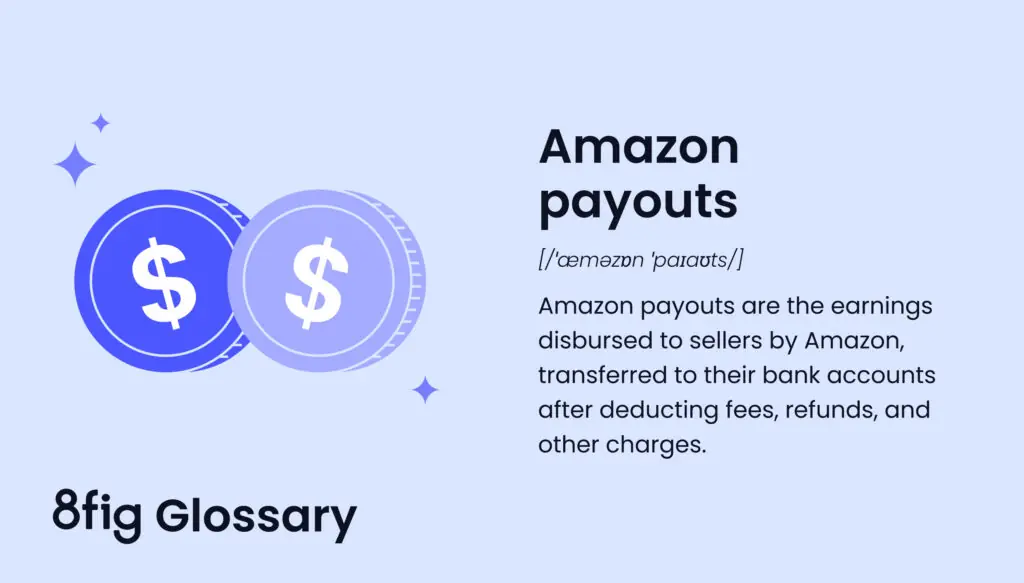Boost your cash flow with 8fig.
Definition
Amazon payouts are the earnings disbursed to sellers by Amazon, transferred to their bank accounts after deducting fees, refunds, and other charges.
What are Amazon payouts?
Amazon payouts refer to the funds Amazon disburses to sellers from their sales revenue. These payments are sent directly to the seller’s linked bank account after Amazon deducts fees, refunds, chargebacks, and any outstanding balances.
For most sellers, Amazon follows a bi-weekly payout schedule, meaning earnings accumulate for 14 days before being released. However, sellers using Amazon Express Payouts or third-party services like Payability can access funds more frequently.
The payout amount depends on net revenue, factoring in order status, delivery confirmation, and Amazon’s hold period for potential returns. While Amazon automates the payout process, sellers must monitor their Account Health and transaction reports to ensure accuracy and avoid unexpected delays.
Understanding Amazon payouts is key to maintaining cash flow, planning inventory restocking, and covering operational expenses without financial bottlenecks.
How it works in eCommerce
Amazon payouts are a crucial part of eCommerce cash flow management, as they determine when sellers can access their earnings. Since Amazon operates on a bi-weekly payout schedule, sellers must plan their finances around these disbursements to cover inventory, marketing, and operational costs.
Unlike traditional online stores that receive payments immediately through direct sales or payment processors, Amazon holds funds for at least seven days after order delivery to account for potential refunds and chargebacks. This delay can create cash flow challenges, especially for high-volume sellers who need to restock quickly.
During peak sales periods like Prime Day or Q4 holidays, payout timing becomes even more critical. Sellers may generate significant revenue but won’t see those funds immediately, requiring careful budgeting to sustain advertising and inventory replenishment while waiting for disbursements.
Some sellers opt for Amazon Express Payouts or external financing to accelerate access to funds, helping them scale without being restricted by Amazon’s standard payout cycle. Understanding how Amazon payouts work allows sellers to optimize cash flow, reinvest in growth, and avoid operational slowdowns.
Benefits
- Automated payments: Amazon handles all transactions and disbursements, eliminating the need for manual invoicing or payment processing.
- Predictable schedule: The bi-weekly payout cycle allows sellers to anticipate earnings and plan their financial strategy accordingly.
- Secure transactions: Amazon mitigates fraud risks by managing payments directly, reducing chargeback disputes and unauthorized transactions.
- Cash flow stability: Consistent payouts help sellers maintain steady operations, ensuring they can reinvest in inventory, advertising, and fulfillment.
- Access to alternative payout options: Sellers can use Amazon Express Payouts or third-party services like Payability to receive earnings faster, reducing financial bottlenecks.
Challenges
- Delayed access to funds: Amazon holds payments for at least seven days after order delivery, which can create cash flow constraints, especially for growing sellers.
- Deducted fees and refunds: Amazon automatically subtracts seller fees, fulfillment charges, refunds, and other expenses before disbursing funds, leading to lower-than-expected payouts.
- Bank processing times: Even after Amazon releases funds, it may take 1–5 business days for the payment to reflect in a seller’s bank account.
- Seasonal cash flow imbalances: High sales during peak seasons don’t immediately translate into available funds, requiring sellers to budget carefully.
- Restricted payouts for new sellers: New accounts may face longer holding periods or reserve balances before receiving their first disbursement.
Might also interest you:
Examples and use cases
- Managing cash flow for restocking inventory: An Amazon seller specializing in home organization products relies on their bi-weekly payouts to reorder inventory. By tracking payout cycles, they ensure they have enough cash on hand to restock bestsellers before running out of stock.
- Covering unexpected business expenses: A fitness brand faces a sudden increase in Amazon FBA storage fees due to a peak in unsold inventory. Since Amazon deducts these charges before disbursing funds, the seller closely monitors payouts to ensure they can cover operational costs without disruptions.
- Sustaining ad campaigns between payouts: A beauty brand running Amazon PPC ads needs to maintain its ad spend while waiting for the next payout. They allocate a portion of their earnings from previous disbursements to keep campaigns running, ensuring continuous visibility and sales growth.
- Navigating delayed disbursements as a new seller: A first-time seller launching a pet supplies brand faces a reserve balance hold on their first payout. To keep their business running, they plan their finances around Amazon’s policies and consider alternative funding options for initial expenses.
- Using alternative payout solutions for faster access: A seasonal toy seller experiences a surge in sales leading up to the holidays but won’t receive their full earnings until after peak season ends. To keep up with demand, they use Amazon Express Payouts for faster access to funds, allowing them to reinvest in inventory and maximize holiday revenue.
Pro tip
Track your payout schedule and factor in Amazon’s holding periods to avoid cash flow disruptions. Plan ahead by setting aside funds for inventory, advertising, and unexpected fees before your next disbursement.
If you need faster access to capital, consider Amazon Express Payouts, Payability, or alternative financing solutions to bridge gaps – especially before peak sales events like Prime Day or Q4 holidays.



